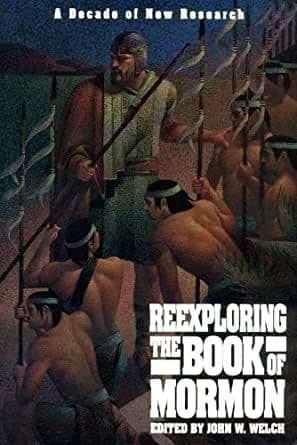Book
85 Chapters

1 Nephi 3:19 “Preserve unto our children the language of our fathers.”
The Book of Mormon testifies that the Nephites were diligent in preserving and teaching Old World languages in the New World, although changes occurred over the years in their spoken and written languages (see 1 Nephi 3:19; Mosiah 1:2; Mormon 9:32-33). Most anthropologists, however, have long held that, except for inconsequential examples, the languages of the Old World never crossed the ocean barriers to the New. Those who have thought otherwise, like the Mormons, have been considered naive. Recent developments in historical and comparative linguistics, though, suggest that the conventional orthodox view has itself been simpleminded, thus holding back serious study of the issue.
Professor Otto Sadovszky of the Department of Anthropology, California State University, Fullerton, has made a revolutionary proposal that two groups of languages separated by over five thousand miles are closely related. The first group is called Penutian, a group of Indian languages of central California that include Miwok and Wintun. The second group is called Ob-Ugrian and includes related languages like Samoyed. These are used around the Ob River of northwest Siberia.
The ten thousand cognate terms and the linguistic quality of the comparisons appear so impressive to Finno-Ugric specialists that they are now more widely accepting historical linkage. A few examples of cognates are Ostyak āj-ko “child” = Miwokan ‘aj-ko “children”; Ostyak lant- “to get blisters from rubbing” = Miwokan lanti “to blister from rubbing.”
Moreover, traditions, physical anthropology, archaeology, and cultural practices (i.e., obsession with the bear in ritual and ideology) of the two areas also confirm a relationship. Sadovszky concludes that these western Siberians moved along the Arctic coast to the Bering Strait, then expanded southward by boat along the salmon fishing grounds of North America (but no further south). On cultural and linguistic grounds, Sadovszky dates the earliest arrivals of Ugrian speakers in central California to around 500 B.C., which is within the archaeological “Middle Horizon” for that area.
He reports evidence that other Indian languages, which were apparently pushed into the California mountains by the newcomers, are related to still earlier Altaic tongues of western Siberia. Thus a whole series of movements, not just one small migration, may well have taken place.1
Interestingly, Sadovszky stumbled onto his study by coincidence. A native Hungarian, he came to Berkeley over twenty-five years ago to study linguistics. Most of the studies of Penutian had been done there, in the area where those Indian languages existed (most of them now extinct). Since Hungarian is an Ob-Ugrian language, he immediately noted connections other investigators had not seen. The lesson is clear: linguistic connections cannot be made until someone capable seriously looks for them.
Meanwhile, a study by Dr. Mary Ritchie Key of the University of California at Irvine addresses another interhemispheric linguistic “no-no.”2 She writes, “The languages of Polynesia contain elements found in North and South American Indian languages that suggest distant historical connections,” then presents some of the evidence. Key has received a flood of new materials from colleagues stimulated by her publication.3
Obviously, if more long-distance linguistic comparisons of any kind were attempted, more such connections in general would be demonstrated and evaluated. Researchers should not be hindered by supposing that the conventional answers are adequate.
This January 1986 Update was based on notes and research by John L. Sorenson, Gordon C. Thomasson, and Robert F. Smith. It is augmented by the considerable research of Brian Stubbs, “Elements of Hebrew in Uto-Aztecan: A Summary of the Data” (Provo: F.A.R.M.S., 1988), demonstrating numerous Hebrew roots and features in the Uto-Aztecan family of Native American languages (see also chapter 82 in this book, “Hebrew and Uto-Aztecan: Possible Linguistic Connections,” pp. 279-81).
1. See Otto Sadovszky, “Data Sheet for Sadovszky’s ‘Cal-Ugrian Theory’,” University of California at Los Angeles, 1985; “The Discovery of California: Breaking the Silence of the Siberian-to-America Migrator,” The Californians 2, no. 6 (November-December 1984): 9-20; “Siberia’s Frozen Mummy and the Genesis of the California Indian Culture,” The Californians 3, no. 6 (November-December 1985): 9-20; “The New Genetic Relationship and the Paleo-Linguistics of the Central California Indian Ceremonial Houses,” Tenth LACUS Forum, 1983, Quebec City, Quebec (Columbia, South Carolina, 1984). For annotations on his work, see John L. Sorenson and Martin H. Raish, Pre-Columbian Contact with the Americas across the Oceans: An Annotated Bibliography (Provo, Utah: Research Press, 1990), 2:S008-17. Publications by Finnish, Estonian, and Russian scholars on a theory called “Nostratics,” which links Indo-European, Afro-Asiatic, and Uralic proto-languages, seem to include initial evidence of the Penutian connection. Tiit-Rain Viitso, for example, published such an article in 1971.
2. Mary Ritchie Key, Polynesian and American Linguistic Connections (Lake Bluff, Illinois: Jupiter Press, 1984); see also John Sorenson and Martin Raish, Pre-Columbian Contact, 1:K062-73.
3. See also John L. Sorenson, “Evidences of Culture Contacts between Polynesia and the Americas in Precolumbian Times,” M.A. thesis, BYU, 1952; and David H. Kelley, “Linguistics and Problems in Trans-Pacific Contacts,” Actas y Memorias, 35th Congreso Internacional de Americanistas (Mexico City, 1964), 1:17-18. Kelley showed the presence of what appear to be specific groups of Uto-Aztecan and early Polynesian cognates clustered around ritual and sacred beliefs.
Book
85 Chapters
Items in the BMC Archive are made publicly available for non-commercial, private use. Inclusion within the BMC Archive does not imply endorsement. Items do not represent the official views of The Church of Jesus Christ of Latter-day Saints or of Book of Mormon Central.